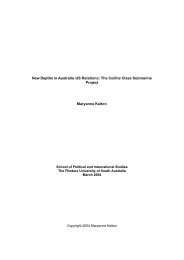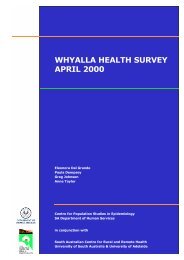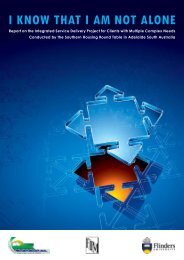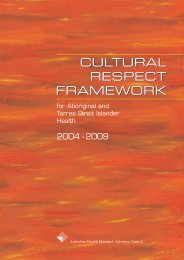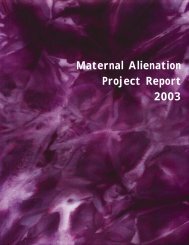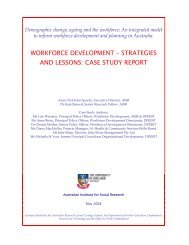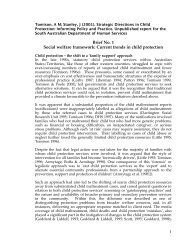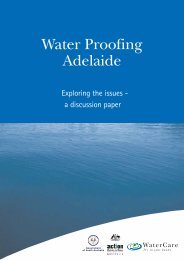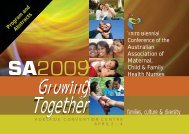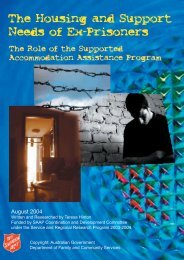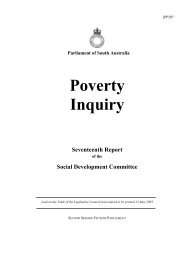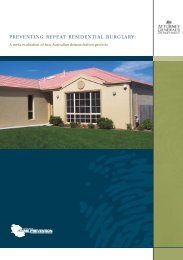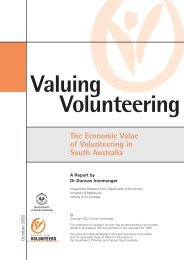Brief No. 2 Social welfare framework - Australian Institute of Family ...
Brief No. 2 Social welfare framework - Australian Institute of Family ...
Brief No. 2 Social welfare framework - Australian Institute of Family ...
Create successful ePaper yourself
Turn your PDF publications into a flip-book with our unique Google optimized e-Paper software.
Wardley & Mackiewicz (1998)<br />
A pr<strong>of</strong>ile <strong>of</strong> the Leaving Care/ Aftercare Services, established in February 1997 is<br />
provided in this paper which explores the history and development <strong>of</strong> the services,<br />
with particular attention focusing on working partnerships. The findings <strong>of</strong> the<br />
study by Judy Cashmore and Marina Paxman’s ‘Longitudinal Study <strong>of</strong> Wards<br />
Leaving Care’ are discussed as are the gaps in service provision identified via<br />
evidence given at the Wood Royal Commission. Partnerships with nongovernment<br />
sub care providers are outlined and areas <strong>of</strong> difficulty are considered.<br />
The Leaving Care Aftercare Forum, March 1998, is briefly reviewed.<br />
Evaluation and research<br />
Johnston (1998)<br />
The aim <strong>of</strong> the research which is the focus <strong>of</strong> this brief overview was to examine<br />
child protection practice and how policy was interpreted into practice, to<br />
understand the extent <strong>of</strong> knowledge practitioners had <strong>of</strong> the principles for practice,<br />
and to gain information about factors that impacted on the implementation<br />
process. The qualitative case study approach used is described, with all children in<br />
the study subject to a care and protection (guardianship) order and placed in out<strong>of</strong>-home<br />
placements.<br />
Tomison (1998b)<br />
The National Child Protection Clearing House is a strong proponent <strong>of</strong> the view<br />
that child abuse prevention programs require effective evaluation. Although in<br />
recent years there has been a greater recognition <strong>of</strong> the need to evaluate programs<br />
adequately, with more pr<strong>of</strong>essionals attempting to implement program<br />
evaluations with some degree <strong>of</strong> methodological rigour, still relatively little is<br />
known about the effectiveness <strong>of</strong> current child abuse prevention initiatives. In part,<br />
this is due to the difficulties in applying experimental rigour to the realities <strong>of</strong><br />
providing services to families. This article reports on an evaluation, conducted by<br />
the <strong>Australian</strong> <strong>Institute</strong> <strong>of</strong> <strong>Family</strong> Studies and Burgell Consulting on behalf <strong>of</strong> the<br />
Brimbank Community Health Service, which aims to evaluate a secondary<br />
prevention program, taking into account the complexities <strong>of</strong> real life family<br />
support work, and its effect on the evaluation process. (Journal abstract, edited)<br />
Vinson & Baldry (2000)<br />
Three studies by the authors are brought together in this paper to better inform<br />
understandings <strong>of</strong> the coincidence <strong>of</strong> poor social environments and child abuse.<br />
The first study brings into question the established operational definition <strong>of</strong><br />
neighbourhood in terms <strong>of</strong> standard census units, such as urban Collector's<br />
Districts in the <strong>Australian</strong> system. The second study is a re analysis <strong>of</strong> the data<br />
from the first study, where confirmed instances <strong>of</strong> child abuse within a Western<br />
Sydney suburb were spatially plotted, revealing the clustering <strong>of</strong> child abuse cases.<br />
38



